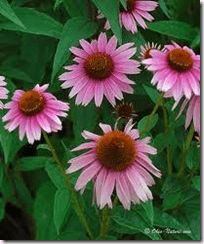Nearly everyone is familiar with the purple coneflower, a long-time resident of Grandmother’s flower garden. In the past several decades, both professional and hobbyist growers have expanded the range of colors to allow the inclusion of coneflowers in nearly any color scheme. Not just pretty flowers, they are also tough customers when it comes to withstanding the rigors of drought and frost. The following article gives you the low-down on adding these beauties to your home.
Use
-
Pink Poodle Coneflower
The coneflower is a hardy perennial flower that puts on a colorful show in the flower border, herb garden or meadow. There are even a few varieties available for growing in container gardens Considered a weed in some areas, coneflowers are tough plants that do well in drought-prone areas. A great plant for filling in bare spots and adding some height to low borders, the coneflower is also outstanding in cut-flower arrangements, its blossoms lasting from 5 to 7 days.
Types
-
 ‘Green Jewel’ Coneflower
‘Green Jewel’ ConeflowerThe most common color is purple. This variety is the source of echinacea, an herbal anti-viral remedy. However, the original coneflower was orange and today’s flowers are its descendants. Through selective breeding, coneflowers are now available in white, pink, red, yellow and even light green. In addition to the familiar daisy-like single blossoms, there are now multi-petaled varieties that more closely resemble asters or zinnias. Some breeders have developed cultivars with frosted or variegated foliage that add even more interest to a planting of coneflowers and companion plants.
Where to Grow
-
Coneflowers were originally native to the hot Plains prairies but are now grown in most temperate regions of the country. Coneflowers are cultivated in growing zones 3 to 8 in the continental U.S. Mimicking the conditions found in their native habitat is the best way to grow a bountiful supply of blooms.
Growing From Seed
-
Coneflowers, especially the purple varieties, are easily grown from seed. Most varieties flourish in sunny, hot, dry, even dusty locations, but don’t mind a bit of shade during the hottest part of the day. If you want to grow your own plants from seed you’ve collected from this summer’s flowers, make sure they’re completely dry, place them in an empty pill bottle or film canister and then put them in the refrigerator for 60 to 90 days. Start your new seedlings in flats a few weeks before your last frost. They germinate in 10 days and need hardening off before planting in the garden.
Growing From Divisions
-
Many gardeners consider dividing coneflowers the easiest way to propagate them. By do this, it’s easier to keep uniformity among the flowers. Those grown from seed are often hybrids and you never know what you’re going to get. Dividing coneflower roots is best done between March and September. To ensure the survival of most of the divisions, make sure you dig a nice big clump of roots. Plants with inadequate root systems tend to die out from added stress. You can either move the divisions directly to their new home or you can coddle them for a few weeks in pots until their roots recover.


Deprecated: strpos(): Passing null to parameter #1 ($haystack) of type string is deprecated in /home/agriviek8Qv/agriviet.net/public_html/wp-includes/comment-template.php on line 2522